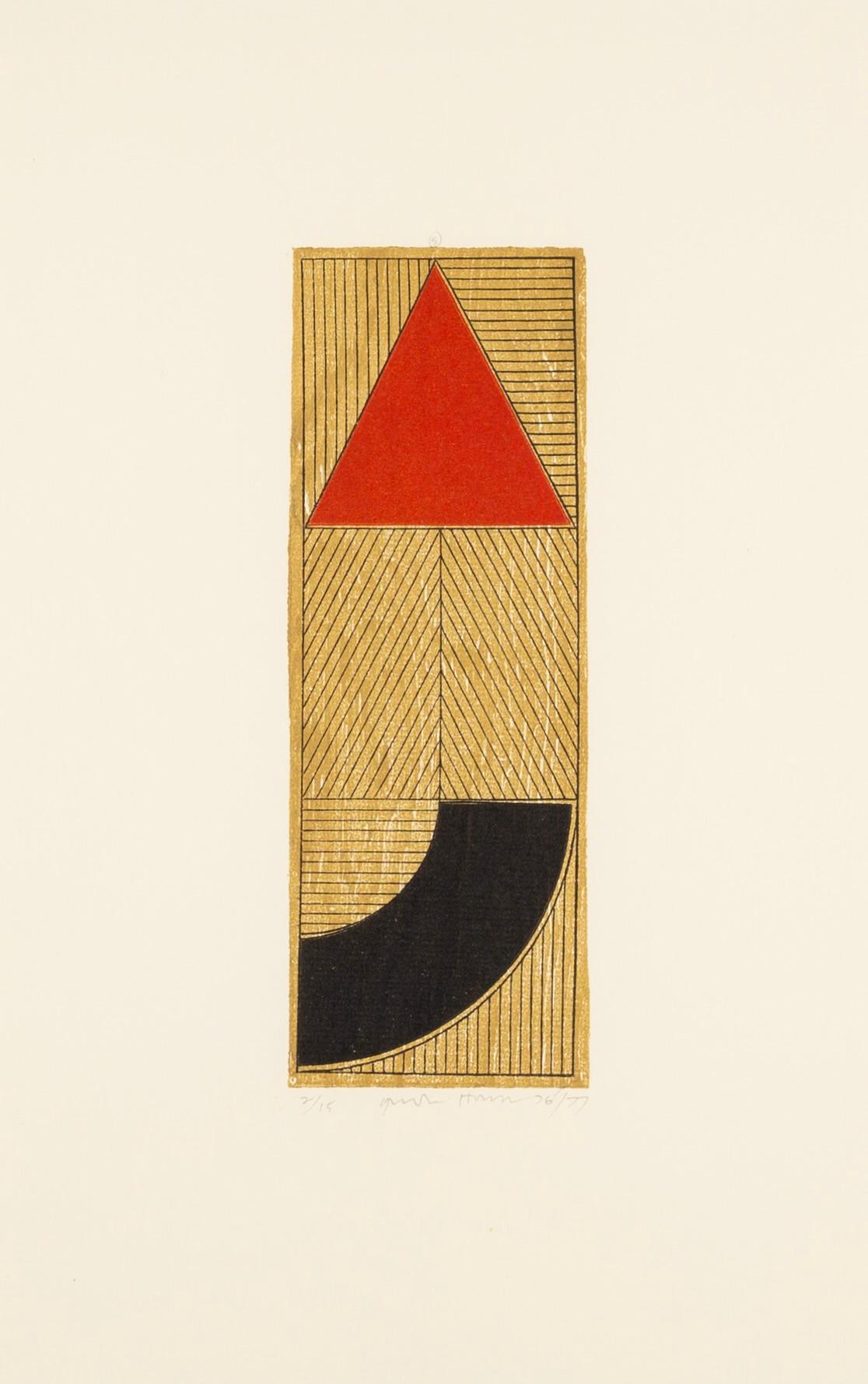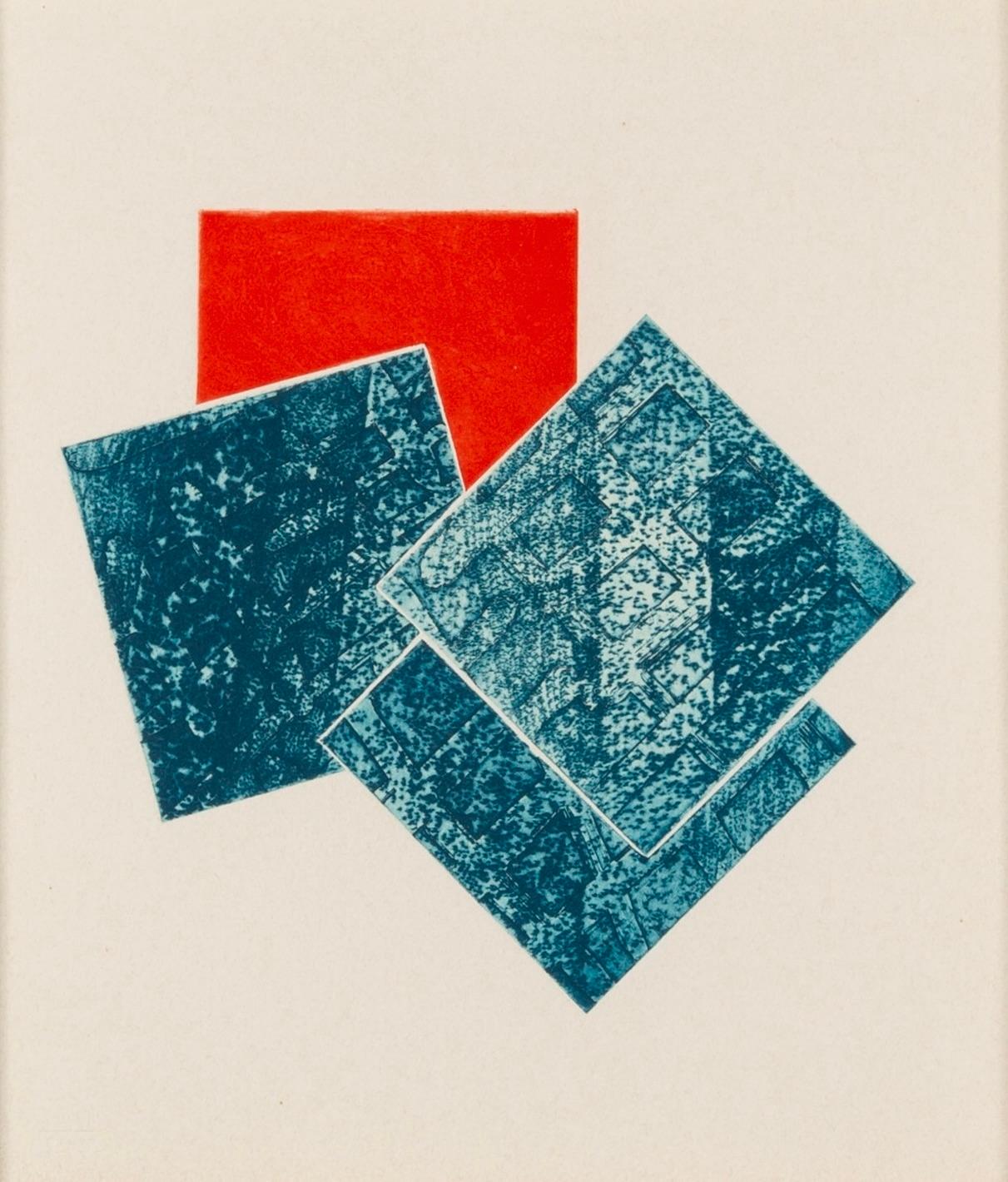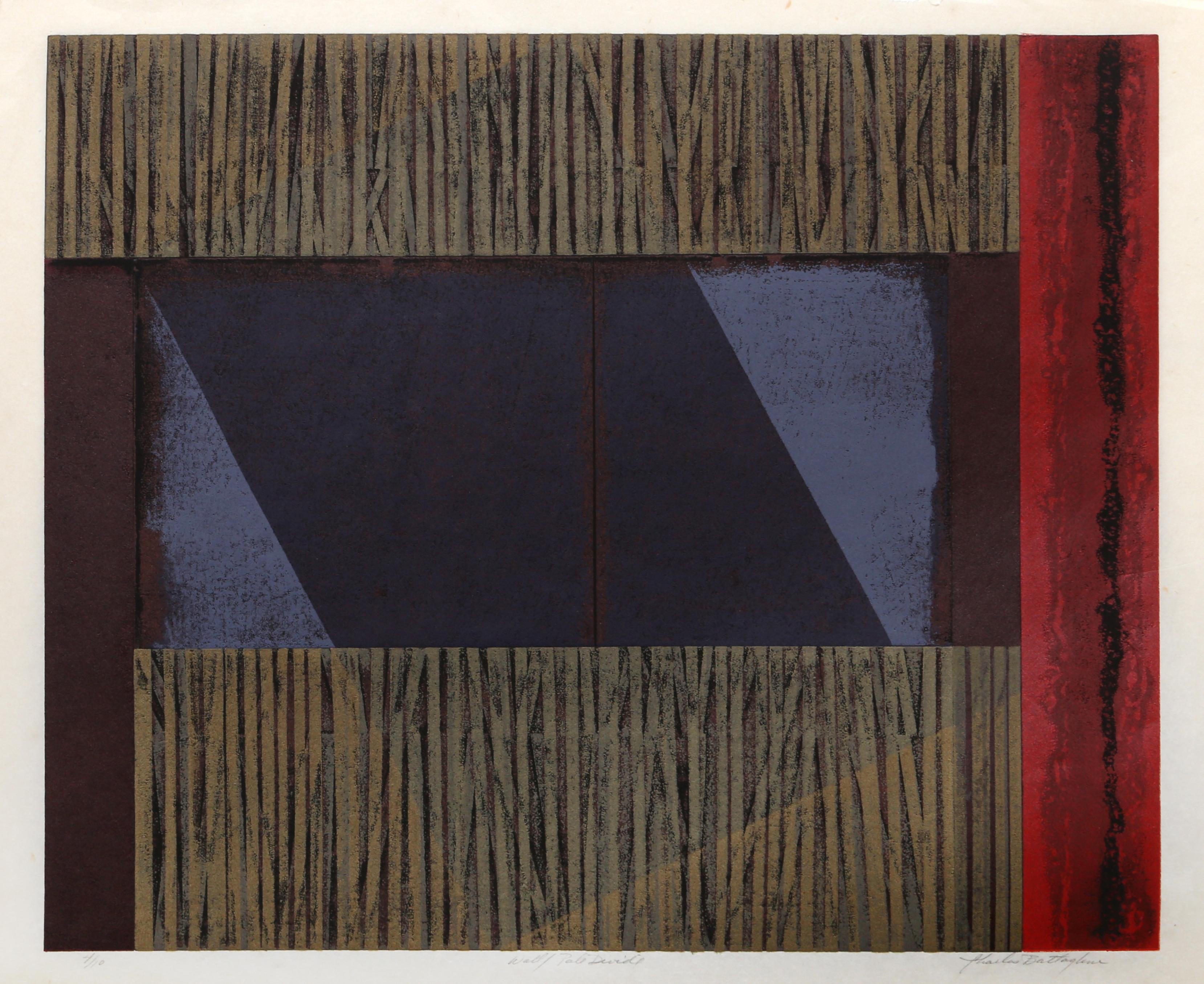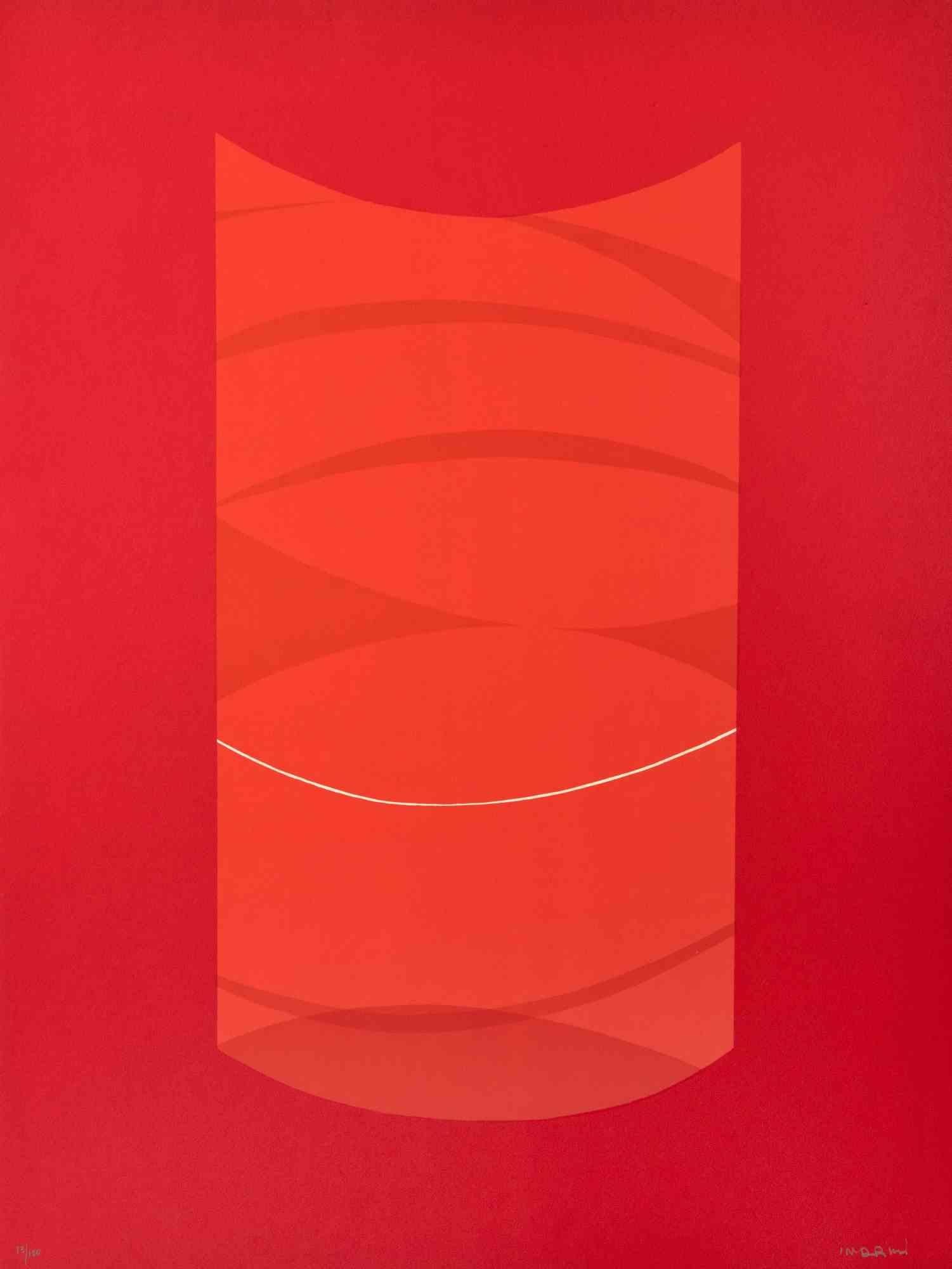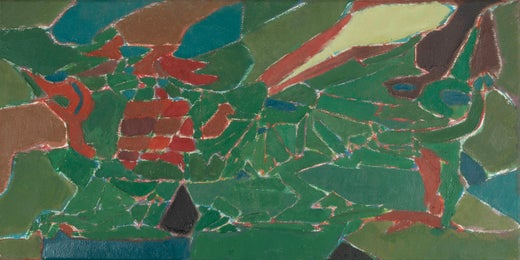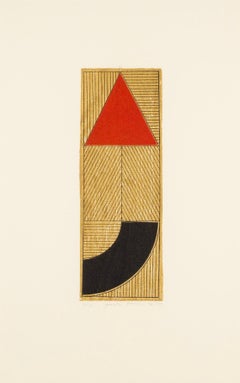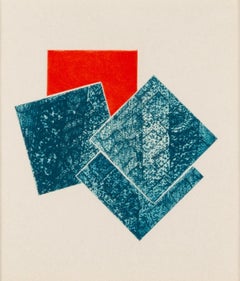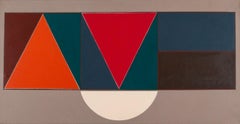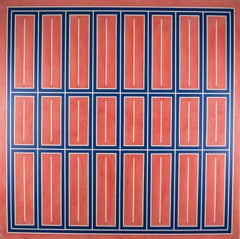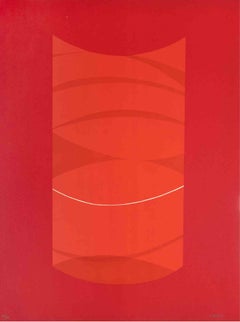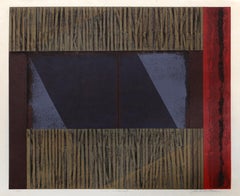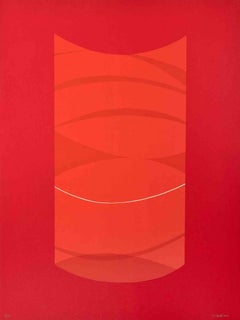Items Similar to Series Tri (H) Small Wood, 1976-77 - Geometric Vertical Woodcut, Red and Grey
Want more images or videos?
Request additional images or videos from the seller
1 of 2
Gordon HouseSeries Tri (H) Small Wood, 1976-77 - Geometric Vertical Woodcut, Red and Grey1976-77
1976-77
$1,585.40
£1,150
€1,342.91
CA$2,192.10
A$2,406.65
CHF 1,255.56
MX$29,123.87
NOK 15,736.45
SEK 14,827.88
DKK 10,024.45
About the Item
Gordon House was born in 1932 in Pontardawe, South Wales. Early exposure to art on trips to the Glynn Vivian Art Gallery as a young boy inspired House towards creative endeavors and at the age of fourteen he was awarded a grant to enter art school which he accepted. From 1947 to 1950 he studied at Luton School of Art, Bedfordshire, and St. Albans School of Art, Hertfordshire. House's contemporaries included Richard Smith and John Plumb with whom he remained close. During the early fifties, after finishing art school, House began work as assistant to the ecclesiastical sculptor Theodore Kern. He also spent time at an advertising studio where he honed his burgeoning skills in typography and graphic design. In 1952 House was offered the position of designer for Imperial Chemical Industries Plastics Division where he stayed until 1959. This was followed by two years spent as graphic designer for the Kynoch Press in London. In 1961 House set out on his own as a self-employed designer and typographer. Initially this was supplemented by part-time teaching at art schools in and around London but by 1964 House was able to devote himself entirely to his design work which freed up valuable time to concentrate on his own artistic output in the studio.
In the late fifties, informed by the new art emerging from America and that of his contemporaries in England, House began to create large-scale abstract works which he was invited to show in 1959 at Dennis Bowen's legendary New Vision Centre in Marble Arch.
House was an active participant in the vibrant London art scene of the sixties, regularly attending lectures, exhibitions and discussions. In 1960 he exhibited in 'Situation' the key abstract exhibition of the decade held at the RBA Galleries. Other participating artists included Robyn Denny, Bernard and Harold Cohen, Gillian Ayres, John Hoyland, Richard Smith and William Turnbull among others. These artists, united by a common admiration for American Abstract Expressionism, were frustrated by the lack of exposure given to large-scale abstract works in commercial galleries so they organised their own exhibition. The name was derived from the participants' idea that an abstract painting that occupied the whole field of vision would involve the spectator in an 'event' or 'situation'. This exhibition was followed by 'New London Situation' in 1961 and a nationwide touring Arts Council presentation in recognition of the significance of the two earlier shows.
In 1961 House began producing his first prints at the Kelpra Studio, run by Chris and Rose Prater, where he made the earliest fine art screenprint ever to be produced in Britain. Artists such as Paolozzi and Hamilton followed in his footsteps and together they started a printmaking revolution in Britain. They cemented the medium of the screenprint in the world of fine art as opposed to the commercial sphere and secured the reputation of Kelpra in the process. Later, together with Cliff White, House set up the White Ink (Ltd.) print studio in London, where he produced etchings and wood engravings on a series of magnificent antique printing presses he had collected. White Ink soon gained a reputation for innovative and high quality printmaking, attracting artists such as R. B. Kitaj, Richard Smith, Joe Tilson, Sidney Nolan, Victor Pasmore, Eduardo Paolozzi, Bernard Cohen and Elizabeth Frink.
Printmaking was to remain a key part of House's oeuvre throughout the rest of his career, whether in the medium of screenprint, etching, woodcut, linocut or lithograph. In 1981 a retrospective exhibition of his graphic works opened at the Carnegie Institute, Pittsburgh, and in 1982 this travelled to the Brooklyn Museum, New York. These shows were instrumental in bringing House's prints to the attention of a wider American audience.
- Creator:Gordon House (1932, British)
- Creation Year:1976-77
- Dimensions:Height: 14 in (35.56 cm)Width: 9 in (22.86 cm)
- Medium:
- Period:
- Condition:
- Gallery Location:Kingsclere, GB
- Reference Number:1stDibs: LU2718215351162
Gordon House
The Guardian wrote of Gordon House, upon his death in 2004: Many of the works made during his last years by the painter and graphic designer Gordon House, who has died aged 71, referred back to his birthplace in the Swansea valley. He spent his earliest years in the steel town of Pontardawe. In Tin-pan Valley, the memoir he published earlier this year, he recalled "the clamour of steel mills ... the tinplate works and pithead gear" and "dynamite blasting as coal seams were struck higher up the valley". Unemployment and the depression of the 1930s led Gordon's parents to take him from the valleys of south Wales to the order and designed coherence of Letchworth, "Hertfordshire's first garden city". After leaving school at 14, he went to study, first, at Luton School of Art. For a while after that, he worked in a hospital, before, with the aid of a scholarship, moving on to St Albans School of Art. By 1961, Gordon had become established among a new generation of artists as an independently minded and adventurous painter and designer. The previous year, he had shown his large, bold, hard-edged canvasses at the important London "Situation" exhibition of large-scale abstract painting, and had designed the catalogue for that exhibition. As the 1960s moved on, Gordon designed for the pop world. He worked for the Beatles, designing their White album and the back of the Sergeant Pepper album, for which his longtime friend Peter Blake designed the front. Later, he designed Wings' first album. He delighted in the creative energy of others, and so could respond to the talents of musicians and artists alike. Gordon made paintings throughout his life as a designer. During the 1960s and 70s, his canvasses and prints reflected the dramatic tensions of his graphic design; by the 1980s, Wales had become his constant subject matter. The surface, texture and colour of his paintings softened. No doubt, he needed to pay homage to the places and the people who had shaped him, just as he always paid homage to the artists for whom he designed. His canvasses reduced in size, becoming palm-of-the-hand landscapes. He spent much time in Wales and, in his final years, he used his brush to walk a path through memories of collieries, valleys, smoking stacks, rows of cottages and the people who had first nurtured him.
About the Seller
No Reviews Yet
Vetted Professional Seller
Every seller passes strict standards for authenticity and reliability
Established in 2010
1stDibs seller since 2024
41 sales on 1stDibs
Typical response time: 8 hours
- ShippingRetrieving quote...Shipping from: Kingsclere, United Kingdom
- Return Policy
Authenticity Guarantee
In the unlikely event there’s an issue with an item’s authenticity, contact us within 1 year for a full refund. DetailsMoney-Back Guarantee
If your item is not as described, is damaged in transit, or does not arrive, contact us within 7 days for a full refund. Details24-Hour Cancellation
You have a 24-hour grace period in which to reconsider your purchase, with no questions asked.Vetted Professional Sellers
Our world-class sellers must adhere to strict standards for service and quality, maintaining the integrity of our listings.Price-Match Guarantee
If you find that a seller listed the same item for a lower price elsewhere, we’ll match it.Trusted Global Delivery
Our best-in-class carrier network provides specialized shipping options worldwide, including custom delivery.More From This Seller
View AllSeries Tri (S) Small Wood, 1976-1977 - Abstract Woodcut Print in Brown + Red
By Gordon House
Located in Kingsclere, GB
Gordon House 1932-2004
Series Tri (S) Small Wood, 1976-1977
woodcut
35.5 x 22.8 cm
14 x 9 in
signed, titled, dated and numbered in pencil
Gordon House was born in 1932 in Pontardawe...
Category
1970s Abstract Prints
Materials
Woodcut
Untitled (Small Etching J), 1979 - Geometric Abstract Print, White, Blue + Red
By Stephen Buckley
Located in Kingsclere, GB
Stephen Buckley b. 1944
Untitled (Small Etching J), 1979
etching and aquatint
28 x 24.2 cm
11 x 9 1/2 in
signed, and dated verso, edition of 40
Stephen Buckley is a British abstrac...
Category
1970s Abstract Prints
Materials
Etching, Aquatint
Double Red Triangle, 1974 - Geometric Abstract Acrylic Painting
By Gordon House
Located in Kingsclere, GB
Gordon House was born in 1932 in Pontardawe, South Wales. Early exposure to art on trips to the Glynn Vivian Art Gallery as a young boy inspired House towards creative endeavors and ...
Category
20th Century Abstract Paintings
Materials
Canvas, Acrylic
Mitred Matrix (Red), 1968 - Bold 1960s Abstract Oil Painting, Geometric Forms
By Gordon House
Located in Kingsclere, GB
Gordon House 1932-2004
Mitred Matrix (Red), 1968
oil on canvas
152.5 x 152.5 cm
60 x 60 in
unsigned, though from the Estate of the Artist
Gordon House was born in 1932 in Pontardaw...
Category
20th Century Abstract Paintings
Materials
Canvas, Oil
Blue/Red Ornament Frieze II, 1976-77 - Large Bold, Bright Abstract Painting
By Gordon House
Located in Kingsclere, GB
Gordon House 1932-2004
Blue/Red Ornament Frieze II, 1976-1977
with Artist's label attached to the stretcher bar
acrylic on canvas
91 x 91 cm
35 7/8 x 35 7/8 in
Gordon House was born in 1932 in Pontardawe, South Wales. Early exposure to art on trips to the Glynn Vivian Art Gallery as a young boy inspired House towards creative endeavors and at the age of fourteen he was awarded a grant to enter art school which he accepted. From 1947 to 1950 he studied at Luton School of Art, Bedfordshire, and St. Albans School of Art, Hertfordshire. House's contemporaries included Richard Smith and John Plumb with whom he remained close. During the early fifties, after finishing art school, House began work as assistant to the ecclesiastical sculptor Theodore Kern. He also spent time at an advertising studio where he honed his burgeoning skills in typography and graphic design. In 1952 House was offered the position of designer for Imperial Chemical Industries Plastics Division where he stayed until 1959. This was followed by two years spent as graphic designer for the Kynoch Press in London. In 1961 House set out on his own as a self-employed designer and typographer. Initially this was supplemented by part-time teaching at art schools in and around London but by 1964 House was able to devote himself entirely to his design work which freed up valuable time to concentrate on his own artistic output in the studio.
In the late fifties, informed by the new art emerging from America and that of his contemporaries in England, House began to create large-scale abstract works which he was invited to show in 1959 at Dennis Bowen's legendary New Vision Centre in Marble Arch.
House was an active participant in the vibrant London art scene of the sixties, regularly attending lectures, exhibitions and discussions. In 1960 he exhibited in 'Situation' the key abstract exhibition of the decade held at the RBA Galleries. Other participating artists included Robyn Denny, Bernard and Harold Cohen, Gillian Ayres, John Hoyland, Richard Smith and William Turnbull among others. These artists, united by a common admiration for American Abstract Expressionism, were frustrated by the lack of exposure given to large-scale abstract works in commercial galleries so they organised their own exhibition. The name was derived from the participants' idea that an abstract painting that occupied the whole field of vision would involve the spectator in an 'event' or 'situation'. This exhibition was followed by 'New London Situation' in 1961 and a nationwide touring Arts Council presentation in recognition of the significance of the two earlier shows.
In 1961 House began producing his first prints at the Kelpra Studio, run by Chris and Rose Prater, where he made the earliest fine art screenprint ever to be produced in Britain. Artists such as Paolozzi and Hamilton followed in his footsteps and together they started a printmaking revolution in Britain. They cemented the medium of the screenprint in the world of fine art as opposed to the commercial sphere and secured the reputation of Kelpra in the process. Later, together with Cliff White, House set up the White Ink (Ltd.) print studio in London, where he produced etchings and wood engravings on a series of magnificent antique printing...
Category
20th Century Abstract Geometric Paintings
Materials
Canvas, Acrylic
Grey, from Study for Larger Tri Motif Series, c. 1977 - Gouache and Watercolour
By Gordon House
Located in Kingsclere, GB
Gordon House was born in 1932 in Pontardawe, South Wales. Early exposure to art on trips to the Glynn Vivian Art Gallery as a young boy inspired House towards creative endeavors and at the age of fourteen he was awarded a grant to enter art school which he accepted. From 1947 to 1950 he studied at Luton School of Art, Bedfordshire, and St. Albans School of Art, Hertfordshire. House's contemporaries included Richard Smith and John Plumb with whom he remained close. During the early fifties, after finishing art school, House began work as assistant to the ecclesiastical sculptor Theodore Kern. He also spent time at an advertising studio where he honed his burgeoning skills in typography and graphic design. In 1952 House was offered the position of designer for Imperial Chemical Industries Plastics Division where he stayed until 1959. This was followed by two years spent as graphic designer for the Kynoch Press in London. In 1961 House set out on his own as a self-employed designer and typographer. Initially this was supplemented by part-time teaching at art schools in and around London but by 1964 House was able to devote himself entirely to his design work which freed up valuable time to concentrate on his own artistic output in the studio.
In the late fifties, informed by the new art emerging from America and that of his contemporaries in England, House began to create large-scale abstract works which he was invited to show in 1959 at Dennis Bowen's legendary New Vision Centre in Marble Arch.
House was an active participant in the vibrant London art scene of the sixties, regularly attending lectures, exhibitions and discussions. In 1960 he exhibited in 'Situation' the key abstract exhibition of the decade held at the RBA Galleries. Other participating artists included Robyn Denny, Bernard and Harold Cohen, Gillian Ayres, John Hoyland, Richard Smith and William Turnbull among others. These artists, united by a common admiration for American Abstract Expressionism, were frustrated by the lack of exposure given to large-scale abstract works in commercial galleries so they organised their own exhibition. The name was derived from the participants' idea that an abstract painting that occupied the whole field of vision would involve the spectator in an 'event' or 'situation'. This exhibition was followed by 'New London Situation' in 1961 and a nationwide touring Arts Council presentation in recognition of the significance of the two earlier shows.
In 1961 House began producing his first prints at the Kelpra Studio, run by Chris and Rose Prater, where he made the earliest fine art screenprint ever to be produced in Britain. Artists such as Paolozzi and Hamilton followed in his footsteps and together they started a printmaking revolution in Britain. They cemented the medium of the screenprint in the world of fine art as opposed to the commercial sphere and secured the reputation of Kelpra in the process. Later, together with Cliff White, House set up the White Ink (Ltd.) print studio in London, where he produced etchings and wood engravings on a series of magnificent antique printing presses...
Category
20th Century Paintings
Materials
Ink, Watercolor, Gouache
You May Also Like
Gordon House, "Untitled - Red Arcs, " Screenprint, 1969
By Gordon House
Located in Long Island City, NY
This screenprint was created by Welsh artist Gordon House (1932-2004). House was a designer and painter whose hard-edged abstract works reflected the dramatic tensions of his graphic...
Category
1960s Abstract Geometric Abstract Prints
Materials
Screen
Red One - Lithograph by Lorenzo Indrimi - 1970s
By Lorenzo Indrimi
Located in Roma, IT
Red One is a contemporary artwork realized by Lorenzo Indrimi in the 1970s.
Mixed colored lithograph.
Hand signed and dated on the lower margin.
Edition of XXV/XXX
Category
1970s Abstract Geometric Abstract Prints
Materials
Lithograph
Wall, Woodcut print by Charles Battaglini
By Charles Battaglini
Located in Long Island City, NY
Charles Battaglini was a professional artist/teacher in printmaking. He exhibited for more than 55 years in juried and gallery exhibits, including the Associated Artists of Pittsburg...
Category
1980s Abstract Geometric Abstract Prints
Materials
Woodcut
Red One - Lithograph by Lorenzo Indrimi - 1970s
By Lorenzo Indrimi
Located in Roma, IT
Red One is a contemporary artwork realized by Lorenzo Indrimi in the 1970s.
Mixed colored lithograph.
Hand signed and dated on the lower margin.
Edition of 73/100
Category
1970s Abstract Geometric Abstract Prints
Materials
Lithograph
Red One - Lithograph by Lorenzo Indrimi - 1970s
By Lorenzo Indrimi
Located in Roma, IT
Red One is a contemporary artwork realized by Lorenzo Indrimi in the 1970s.
Mixed colored lithograph.
Hand signed and dated on the lower margin.
Edition of II/XXX
Category
1970s Abstract Geometric Abstract Prints
Materials
Lithograph
Red One - Lithograph by Lorenzo Indrimi - 1970s
By Lorenzo Indrimi
Located in Roma, IT
Red One is a contemporary artwork realized by Lorenzo Indrimi in the 1970s.
Mixed colored lithograph.
Hand signed and dated on the lower margin.
Edition of 73/100
Category
1970s Abstract Geometric Abstract Prints
Materials
Lithograph
More Ways To Browse
Vintage House Keys
Jewish Woodcut
Jules Perahim
Kaws Bearbrick
Klimt 1931
Last Supper Print
Lee Quinones
Lithograph Chagall Bouquet
Marc Chagall 1957
Marie Laurencin Etchings
Max Jaffe Print
Montserrat Gudiol
Picasso Human Comedy
Pierre Auguste Renoir Etching
Poster 1970 Picasso
Rebecca Baird On Sale
Reclining Woman Print
Reginald Marsh Etching
